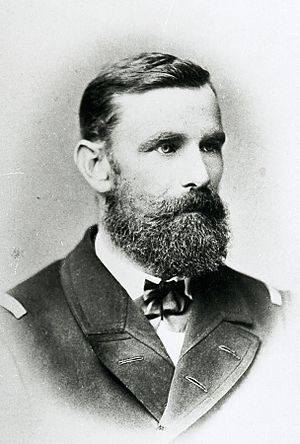Karl Weyprecht facts for kids
Quick facts for kids
Karl Weyprecht
|
|
|---|---|
 |
|
| Born | 8 September 1838 Darmstadt, Germany |
| Died | 3 March 1881 (aged 42) Michelstadt |
| Allegiance | |
| Service/ |
|
| Rank | k.u.k. Linienschiffsleutnant |
| Commands held | Co-led, with Julius von Payer, the 1872–1874 Austro-Hungarian North Pole Expedition that discovered Franz Josef Land |
| Battles/wars | Austro-Sardinian War Battle of Lissa (1866) |
Karl Weyprecht (born September 8, 1838, died March 2, 1881) was a brave explorer from Austria-Hungary. He was an officer in their navy. Karl Weyprecht is best known for his amazing trips to the Arctic, the cold northern parts of the world. He also strongly believed that countries should work together to study the North and South Poles. He helped start the idea for the first International Polar Year, a big science project, even though he passed away before it happened.
Contents
Karl Weyprecht began his studies in 1852 at a school called Gymnasium in Darmstadt, Germany. Later, he moved to another school, which is now known as Technische Universität Darmstadt.
In 1856, he joined the Austro-Hungarian Navy. He served in a conflict known as the Austro-Sardinian War. From 1860 to 1862, he worked on a ship called Radetzky. He served under Admiral Tegetthoff. From 1863 to 1865, he was an instructor on a training ship named Hussar.
On July 23, 1865, Karl Weyprecht met a German geographer named August Petermann. This meeting happened at a "Geographic Society" gathering in Frankfurt. He also served in a sea battle in 1866, known as the Battle of Lissa (1866). He was on a ship called Drache.
Exploring the Arctic
In 1870, Karl Weyprecht met Julius von Payer. They became good friends and decided to explore together. In 1871, they went on an early trip to Novaya Zemlya, a group of islands in the Arctic.
On February 18, 1872, Weyprecht officially became a citizen of Austria-Hungary.
The North Pole Expedition
Karl Weyprecht and Julius von Payer led a big trip to the North Pole. This was the Austro-Hungarian North Pole Expedition, which lasted from 1872 to 1874. During this journey, they discovered a group of islands called Franz Josef Land in the Arctic Ocean.
Their ship, the Admiral Tegetthoff, got stuck in the thick ice. They had to leave the ship behind. The explorers then traveled on sleds further north. When they reached open water, they used boats. They finally made it to the Black Cape of Novaya Zemlya. There, they met a Russian schooner (a type of boat) named "Nikolaj." This boat was led by Captain Feodor Voronin.
The Russian ship took them to Vardø, Norway. From there, they took a mail boat south and eventually returned home to Vienna. For his amazing discoveries, Karl Weyprecht received the Royal Geographical Society's Founder's Medal in 1875.
Ideas for Arctic Research
After his expeditions, Karl Weyprecht had important ideas about studying the Arctic. On September 18, 1875, he spoke at a meeting in Graz, Austria. He talked about the "basic principles of Arctic research." He suggested that permanent research stations should be set up in the Arctic.
Weyprecht believed it was important to have a network of these stations. They would all take regular measurements of weather and ice conditions. They would use the same tools and take measurements at the same times. This way, scientists could compare information from different places.
In 1879, he shared these ideas with George Neumayer at a big meeting in Rome. This meeting was the 2nd International Congress of Meteorologists.
Karl Weyprecht passed away in 1881 from a lung disease called tuberculosis.
Remembering Karl Weyprecht
Many things have been named or created to remember Karl Weyprecht and his work:
- A special coin was made in Austria on June 8, 2005. It is called the Admiral Tegetthoff Ship and The Polar Expedition commemorative coin. One side of the coin shows two explorers in Arctic gear with their frozen ship, the "Admiral Tegetthoff," behind them.
- A Swedish musician named Stina Nordenstam created a sound art piece called Isens Fasor. The words spoken in this art piece came directly from Karl Weyprecht's own expedition journal.
- Several places in the Arctic are named after him, including the Weyprecht Mountains, Cape Weyprecht, Weyprecht Fjord, Weyprecht Glacier, and Weyprecht Islands.
- In 2013, a base camp in Morocco for a space research mission was named Camp Weyprecht. This was done during a special ceremony on February 11, 2013.
See also
 In Spanish: Karl Weyprecht para niños
In Spanish: Karl Weyprecht para niños

